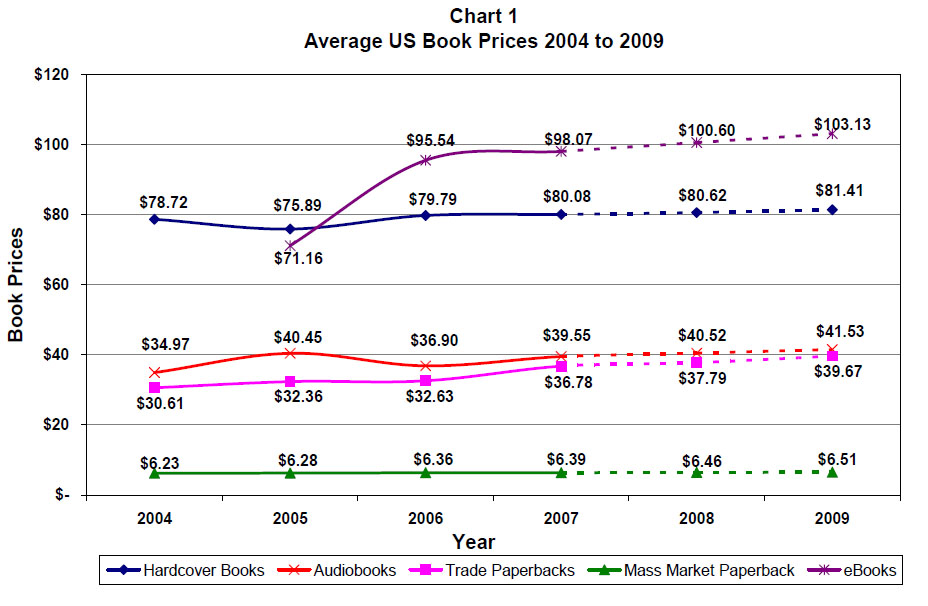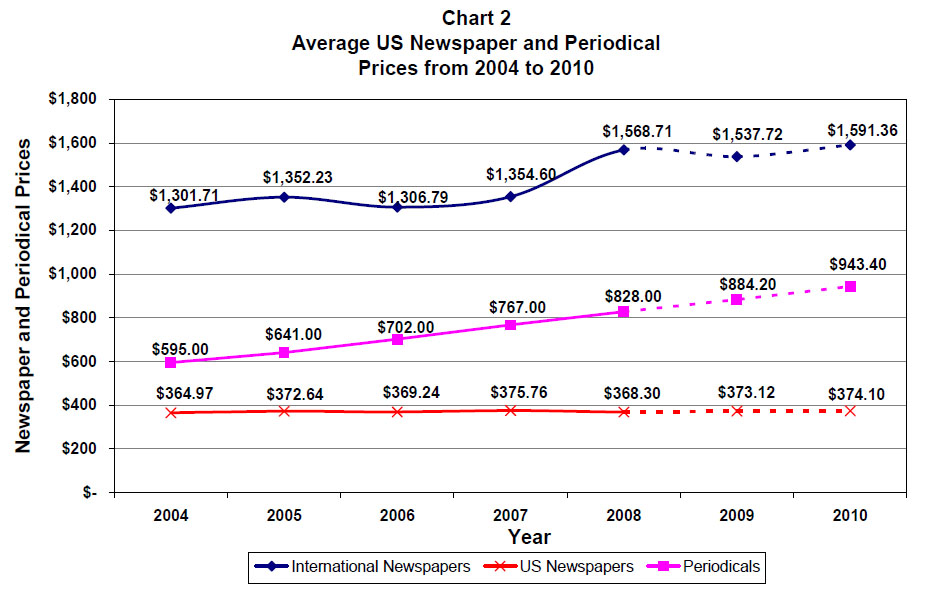Books
During times of a slowing economy and the tightening of city, state, and national budgets, it is important to prepare for how to best meet the needs of library patrons. Studying trends in library material price changes helps to anticipate the challenges of collection development. Libraries face ever-increasing prices for materials and on a yearly basis the prices go up and down, but the overall trend is a steady increase in prices.
Trade paperbacks are leading price increases with a 20.2 percent change between 2004 and 2007. Continuing this trend, prices would increase approximately 4 percent per year (see Chart 1).
 Source: http://www.ybp.com/title_reports_2007.html; Bogart, D. (2008).[note]Bogart, D. (ed.). (2008). The Bowker Annual Library and Book Trade Almanac, 53rdEdition. 2008. New Providence, NJ: R. R. Bowker.[/note] Note: 2008-09 based on trend analysis.
Source: http://www.ybp.com/title_reports_2007.html; Bogart, D. (2008).[note]Bogart, D. (ed.). (2008). The Bowker Annual Library and Book Trade Almanac, 53rdEdition. 2008. New Providence, NJ: R. R. Bowker.[/note] Note: 2008-09 based on trend analysis.
During this same period, audio book prices experienced the second highest increase with a change of 13.1 percent. Although audio book prices tend to fluctuate up and down along with audio book sales, overall prices are trending up 2.5 percent per year (see Chart 1).
The desire to provide library patrons with materials on multiple platforms is increasing the sales of electronic books (e-books). Prices rose drastically with an increase of 37.8 percent between 2005 and 2006 following an average sales increase of 34.5 percent between 2004 and 2006. YBP Library Services believes that e-book prices have stabilized with market demand. Future price increases are expected to be less volatile, likely following print book pricing trends.[note]Bruning, N. (October, 2008). Annual Book Price Update. YBP Library Services. Retrieved on November 15, 2008 from http://www.ybp.com/book_price_update.html.[/note]
Newspapers and Periodicals
While the material price of international newspapers has remained steady, the cost of shipping has brought about a recent sharp increase in the absolute price (see Chart 2). The number of U.S. newspapers is slowly decreasing and the price change has been relatively small. Increasing popularity of the online news format is forcing some newspapers to keep prices low, or move to online only formats, in order to stay competitive.[note]Bogart, D. (ed.). (2008). The Bowker Annual Library and Book Trade Almanac, 53rdEdition. 2008. New Providence, NJ: R. R. Bowker.[/note]
Periodical prices rose 39.2 percent between 2004 and 2008. However, prices may increase around 6.7 percent in both 2009 and 2010 (see Chart 2). According to The Bowker Annual Library and Book Trade Almanac, 53rd Edition, periodical publishers are looking for better ways to price periodicals because libraries are having difficulty affording print and online versions of journals.[note]Bogart, D. (ed.). (2008). The Bowker Annual Library and Book Trade Almanac, 53rdEdition. 2008. New Providence, NJ: R. R. Bowker.[/note]
Source: Van Orsdel, L., & Born, K. (2008);[note]Van Orsdel, L., & Born, K. (2008). Embracing Openness. Library Journal (1976), 133(7), 53-8. Retrieved October 28, 2008, from Library Lit & Inf Full Text database.[/note] Bogart, D. (2008)[note]Bogart, D. (2008).[/note]
